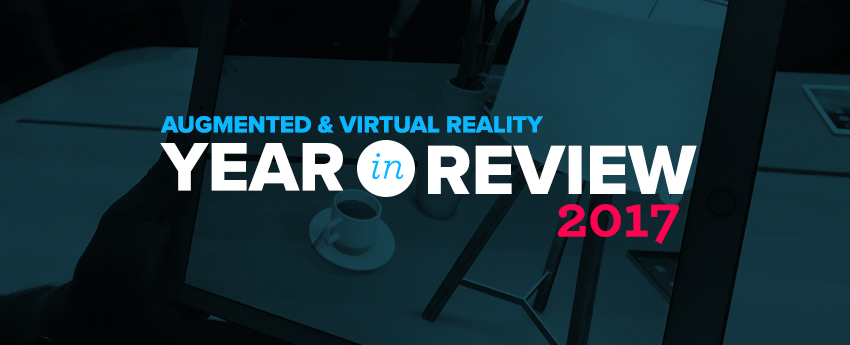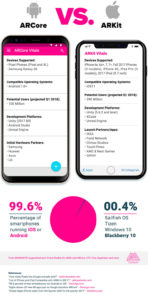
For more information on Augmented and Virtual Reality solutions, check out our 3D Cloud™ pages, which explain ways businesses are harnessing the technology currently sweeping retail.
2017: A year of progress for Augmented and Virtual Reality
Arriving on the heals of a breakthrough 2016 for Augmented and Virtual Reality, 2017 was a year of continued momentum and refinement — along with the earth-shaking arrival of Augmented Reality Software Development Kits (SDKs) from two of the biggest companies on the planet. There was plenty of new hardware, a flood of consumer-facing apps that used Augmented Reality for retail, and a year’s end uptick in VR hardware sales that bodes well for the future of the industry. What follows are our picks for the biggest stories from the world of VR and AR over the last 12 months.
Top 5 stories in Augmented and Virtual Reality in 2017:
#1. Apple’s ARKit brought Augmented Reality to the mainstream
There was no bigger story in 2017 than Apple’s unveiling of its ARKit SDK, which brought native support for markerless Augmented Reality applications to the iOS platform. Unveiled at the Worldwide Developer’s Conference in June, Apple’s ARKit demo blew away the crowd, and was quickly followed by a flood of YouTube proof-of-concept videos, as developers created digital tape measures, real-world Minecraft games and one impressive riff on the music video for A-Ha’s “Take on Me.”
The tech was so impressive that Google immediately all but abandoned their Tango platform and took the wraps off ARCore, which essentially brought iOS’s shiny new markerless AR functionality to Android. Google unveiled ARCore in August, but had some catching up to do to match Apple’s installed user base. (Estimates put the number of Apple devices capable of running ARKit-based apps at launch in the hundreds of millions.) That said, by this time next year there should be parity as far as the underlying technology, though it remains an open question as to whether developers will embrace both platforms. What’s good for iOS has usually been good for Android, and Augmented Reality adoption should be no different.

#2. Retailers scrambled to add AR/VR to the shopping experience
Apple’s focus on Augmented Reality had a host of side effects that we’ll all be feeling for years to come. Along with ARKit came a new operating system, iOS11, which was built to feature AR experiences, and a wave of new devices with powerful camera systems that make AR applications even more accurate. Upon iOS11’s release at the end of September, dozens of retailers jumped at adding AR capabilities to their apps, letting users check out furniture and home goods from the comfort of their living room.
The first wave of AR preview apps was led by IKEA, whose IKEA Place app quickly became the measuring stick for whether an AR furniture app provided a realistic shopping experience. In addition to Ikea, Wayfair, Anthropologie, Ashley Furniture, Amazon and others all introducing apps that allow the user to preview products in their own home.
On the VR front, ambitious projects from some of the biggest names in retail pointed the way to a future where shopping and Virtual Reality are forever linked. Early implementations include Ashley HomeStore’s VR Showroom and Macy’s Virtual Reality Experience, both of which features an iPad design app and fully immersive VR experience that allow users to recreate their living room in the store before filling it with photo-realistic products.
In addition, luxury home builder Toll Brothers is using Virtual Reality to let homebuyers check out different floor plans and options from the model center, and then using VR in their design studios to let customers see how different option packages work together before they commit.
As businesses tried out different Augmented and Virtual Reality sales solutions, tech companies continued pumping out more and more powerful devices to meet the new use-cases. The most popular was the iPhone X, which featured a cutting edge depth-sensing camera system and was sold with a pitch that highlighted the device’s AR capabilities. There were also plenty of competing devices from Sony, Google, Huawei and others that made it clear that AR would be a must-have smartphone feature for years to come.
By year’s end, a renewed focus on Virtual Reality seemed to be underway as well. Among the developments: Amazon announced a new service called Sumerian, that would leverage Amazon Web Services to make developing VR applications much simpler for developers. Not to be outdone, Facebook took the wraps off a Web-based Virtual Reality News Feed. And speaking of the Web, Google is now building VR capabilities into its Chrome Web browser.
#3. There was plenty of investment money flowing into AR/VR
The best way to gauge the health of an industry is to follow the money flowing into or out of it. Retail sales figures are important, of course, but you also have to check the pace of investment to say whether or not burgeoning technologies like Virtual and Augmented Reality have the support of the venture capital community. Without that support, even the best idea will founder in today’s highly competitive business environment.
That’s why it was reassuring to see some major investment in AR and VR technologies during the previous 12 months. To put the numbers in perspective, 2016 saw a total of $2.3 billion invested in AR/VR. That number had been surpassed by November of 2017, with a total of $2.5 billion already invested with up and coming companies.
Back in May, British VR startup Improbable raised $500 million in Series B funding. Improbable uses distributed computing to allow for “the creation of virtual worlds for use in games or for ‘massive-scale simulations of the real world’,” and the $500 million investment is the largest ever in a European tech startup.
Back on the U.S. side of the pond, 3D engine creator Unity cast its own funding net and managed to reel in a $400 million investment from private equity firm Silver Lake. Per a story in Virtual Reality News, it was the continued growth of the gaming industry, and the predicted upward trajectory of VR and AR, that attracted Silver Lake to Unity. It didn’t hurt that Unity’s software runs on over 2 billion devices worldwide, giving the company a massive installed user base from which to grow.
No discussion of investment in AR and VR would be complete without a reference to Magic Leap. The secretive South Florida startup has already reaped billions in venture funding from the likes of Google and Alibaba, but that didn’t stop Magic Leap from going back to the VC well in October to raise another $500 million. There is still no word on when Magic Leap’s rumored AR technology will come to market, but with the rumor mill saying the company needed this round of investment to move from prototype to production, hopefully the big reveal is coming sooner than we think.
#4 – There was new hardware, but no killer app
After 2016’s “Big Bang” of hardware releases, 2017 was more of a transitional year, complete with some new products, refinements on existing ones, and a general move toward a wireless future. Google led the charge on the wireless front, with a May announcement of forthcoming untethered headsets. According to The Verge, “The headsets track virtual space with something Google calls ‘WorldSense,’ powered by technology from its Tango Augmented Reality system. Google is creating a reference design with help from Qualcomm, and it’s also working with HTC and Lenovo for standalone headsets.”
By the end of the year, HTC had actually backed out of its Google partnership — but that doesn’t mean the company didn’t have other hardware ideas up its corporate sleeves. In July, HTC announced a “premium” VR headset that would initially be available only in China. The new HMD will be built on the Qualcomm Snapdragon 835 mobile VR platform, itself designed to support built-in VR functionality.
HTC wasn’t the only manufacturer to try for a high-end HMD. In September, Pimax took the wraps off an 8K VR HMD, with Founder & CEO Robin Weng telling Virtual Reality News, “The 8K VR headset allows people to become a part of the ultra-high definition environment, by digitizing 2D illustrations from a screen and transforming the very environment around you, invoking a whole new level of emotion while in this 3D virtual space. The 4K was a brilliant breakthrough, and we have grown from that into the next step with the 8K headset, bringing a more genuine realism to Virtual Reality. We are closing the gap between reality and the digital world.”
It wasn’t just traditional tech companies jumping into the Virtual Reality hardware game. Family entertainment behemoth Disney announced in July that it would team with Lenovo to produce an Augmented Reality headset, which would allow the Mouse House to develop AR content around its intellectual property (think: Star Wars AR Lightsaber battles) and feed it directly to its own hardware platform.
One More Thing …
Right after we posted this story, secretive South Florida start-up Magic Leap finally revealed the Magic Leap One, an Augmented Reality headset that has been the subject of unending rumors for over two years. Magic Leap has received billions in funding from giants like Google and Alibaba, and this instantly becomes the most important hardware reveal of 2017. For now details on the Magic Leap One are scant, but we’ll have much more on this exciting piece of tech in the new year.
#5. Existing hardware sold well and saw price cuts
There’s a reason we saw a record number of hardware announcements in 2017: It turns out consumers are buying VR and AR hardware. This may come as a bit of a surprise, as there was plenty of gloom and doom amongst media talking heads about how Virtual Reality had “plateaued” in 2017. Spring and summer hardware price cuts from HTC and Oculus fed into the notion that the market was faltering, making it easy to buy into the negativity.
The numbers, however, told a much different story. Back in February, Sony was already setting a strong pace with the PSVR, announcing it had sold more than 900,000 PSVR units, and was well on its way to 1 million. The problem was that HTC and Oculus were locked in a price war, with reductions coming in March and again in July. Was Sony’s success coming at the expense of its pricier rivals?
By the end of the year, it was clear the market as a whole was growing, and was big enough to support all the players — at least for the moment. As the holiday shopping season got underway, Sony remained in the sales lead, but things had picked up for both HTC and Oculus. Looks like those price cuts worked!
And as the year came to an end, a different hardware-related headline was making a splash — For the first time, VR headset shipments hit 1 million units a quarter. On to 2018!












